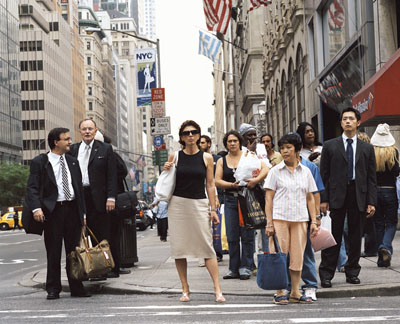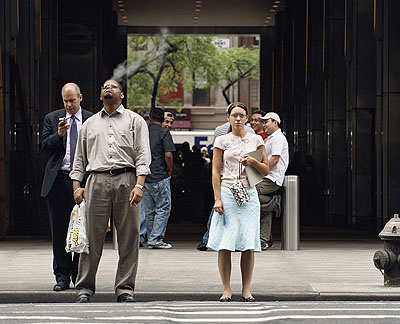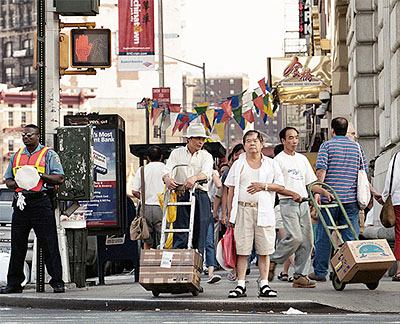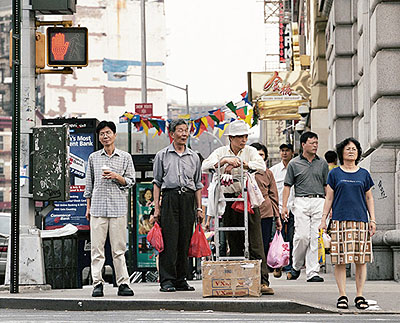
Wait for Walk - 48th St /5th Ave, 2005
Florian Böhm »
Exhibition: 1 Feb – 29 Mar 2008

Wait for Walk - 40 west 57th street
Exhibition 1. February - 29th March 2008 Opening: 31st January, Florian Böhm will sign his new catalogue Wait for Walk (published by Hatje Cantz) Concurrently: Forum 11, Fotomuseum, Munich, 25. January - 23. March 2008 Galerie f5,6, Munich, Germany is proud to present works by Florian Böhm on the occasion of the publication of his new catalogue Wait for Walk (Hatje Cantz Verlag) and an exhibition at the Fotomuseum in Munich. The gallery will show works from the series Wait for Walk as well as selected earlier works since 1997. Florian Böhm's work first reached international recognition with the joint archival project Endcommercial®, Reading the City (with Wolfgang Scheppe und Luca Pizzaroni). This project was shown internationally in 2002 at renowned Museums and Institutions and published as a book by Hatje Cantz. The three artists documented New York City like a kind of image dictionary with hundreds of images, arranged into topics like, broken down bicycles, street lanterns, garbage cans, shopping carts, shop signs, plastic bags, street signs, vendor tables etc. What becomes visible through this work is how people form but also alienate their environment. Through its specific selection and arrangement into a typological system in Endcommercial®, complex sub-cultural conventions and objectified social contradictions of the city become apparent and are registered by the viewer. In his new series Wait for Walk Florian Böhm expands the typology of the urban space into a kind of anthropological study of the metropolitan inhabitant. They are studies of waiting passers-by at traffic lights in Manhattan. Through the constant rhythm of a metropolis these moments are short lived, transient, and forever changing constellations of people of all ages, ethnicities, social classes and so forth. From the outset Florian Böhm had very precise conditions in mind, which originate in the idea of the "Dérive-concept" of the Situationists. This stipulates that there should be no subjective or aesthetic influences or pictorial strategies deterring from an objectified view of urban reality. In Wait for Walk, Florian Böhm photographed largely unobserved by his subjects and within the time frame of passing cars. It is, in fact, purely the rhythm of the traffic flow serving the pace that creates short-lived constellations, fleeting group portraits that form purely out of chance echoing moments of great urban authenticity. In their precise recording of the "event", the images reveal an arresting panoptic of human individuality and non-verbal communication even though the protagonists, are totally anonymous. Yet the viewer, who like the photographer, are in the same position across the street, is magically drawn into these small moments of human life and individual stories almost as if these random constellations of people were participating in a theatre play where the sidewalk has been transformed into a stage. "In the photographs of Wait for Walk, the people shown are not presented as anonymous mass decoration but are discernibly individual, permanently rescued from facelessness and historical oblivion. We recognize a differentiated spectrum of city dwellers of all ages and ethnic identities. But who are these people, where do they come from, and where are they bound? One is tempted to raise these existential questions, like Gauguin in his famous picture Where Do We Come From? What Are We? Where Are We Going?" Extract from the catalogue Wait for Walk "On the Physiology of the Street, or: The Drama of Urban Life" by Dr. Ulrich Pohlmann The intention of the "unobserved" moment partly lies within the American tradition of street photography of artists like Helen Levitt, Sid Grossman, Lisette Model or William Klein to name but a few, and extend into the contemporary images like Thomas Struth's Museum pictures. Concurrently Böhm's works, interestingly, also are close to the staged and calculated tradition in photography of artists like Jeff Wall or Phillip Lorca diCorcia. It is perhaps this combination that makes the work so arresting to the viewer: The accidental grouping of people with the aesthetic of a stage-like production - perhaps a modern inversion of the baroque Dutch principle of the group portrait? Florian Böhm's works were exhibited at Haus der Kunst, Munich, Germany in Storefront for Art and Architecture, New York, Fondation Cartier pour l'Art Contemporain, Paris, Kunstwerke, Institute for Contemporary Art, Berlin, and Fondazione Adriano Olivetti, Rom. From the end of January 2008 at Fotomuseum, Munich.
Ausstellung: 1. Februar - 29. März 2008 Eröffnung: 31. Januar, Florian Böhm signiert seinen neuen Katalog Wait for Walk (Hrsg.: Hatje Cantz Verlag) Zeitgleich: Forum 11, Fotomuseum, München, 25. Januar - 23. März 2008 Es ist das große Schauspiel des Lebens, das nur dann zur Aufführung kommt wenn die Stadt für einen Augenblick den Atem anhält Die Galerie f5,6 München zeigt Arbeiten des in München und New York lebenden Künstlers Florian Böhm, anlässlich des Erscheinens von Wait for Walk, (Hrsg.: Hatje Cantz Verlag) und der gleichnamigen Ausstellung im Fotomuseum München. Die Galerie f5,6 präsentiert dabei Motive aus dem Projekt Wait for Walk sowie einen ausgesuchten Querschnitt Böhms früher Arbeiten (seit 1997). Mit dem gemeinschaftlichen Archiv-Projekt Endcommercial®, Reading the City (zusammen mit Wolfgang Scheppe und Luca Pizzaroni) erlangte Florian Böhm erste internationale Anerkennung. Das Projekt wurde 2002 vielfach erfolgreich International in renomierten Museen und Institutionen ausgestellt und als Buch im Hatje Cantz Verlag publiziert. Am Beispiel New Yorks dokumentiert die bildlexikalische Arbeit der drei Künstler Strukturen der urbanen Improvisation und zeigt Strategien des Zurechtkommens in der Ökonomie der Straße. Sie macht sichtbar, wie der Mensch seine Umgebung - Laternen, Abfalleimer, Getränkekisten, Einkaufswagen, Ladenschilder oder Plastiktüten - nutzt, formt und zweckentfremdet. Durch die Selektion und die Ordnung in einem typologischen System werden subkulturelle Konventionen und vergegenständlichte soziale Widersprüche der Stadt erkennbar. Überrascht gewinnt der Betrachter plötzlich Einsicht in die Differenz vom oft Gesehenen und niemals Registrierten. In der neuen Werkgruppe Wait for Walk erweitert Böhm die Typologie des urbanen Raums um eine Anthropologie der Großstadtmenschen: Studien wartender Passanten an Ampeln in New York in wechselnden und flüchtigen Konstellationen, erzeugt und arretiert durch den Rhythmus der Metropole, unbemerkt von Florian Böhm festgehalten. Die Serie ist unter klar definierten Rahmenbedingungen entstanden und erinnert an das "Dérive-Konzept" der Situationisten, bei dem durch Aufnahmetechnik subjektive, bildgestalterische Einflüsse des Fotografen vermieden werden sollen um somit ein möglichst objektives Abbild urbaner Wirklichkeit zu erreichen. In der Serie Wait for Walk gibt der Rhythmus des Verkehrsflusses den Takt vor und es entstehen so kurzzeitige Konstellationen, flüchtige Gruppenbilder, die sich selbst formieren. Florian Böhm fotografierte meist unbeobachtet und im Zeitfenster vorbeifahrender Autos, so wird der Verkehrsfluss zum Verschlussvorhang und es entstehen Momente großer Authentizität. In ihrer präzisen Aufzeichnung des Geschehens offenbaren die Bilder bei aller Anonymität der Protagonisten ein fesselndes Panoptikum menschlicher Individualität und nonverbaler Kommunikation. "In den Fotografien aus "Wait for Walk" sind die dargestellten Personen nicht als anonymes Massenornament wiedergegeben sondern in ihrer Individualität erkennbar ... . Wir erkennen ein differenziertes Spektrum an Großstadtbewohnern aus sämtlichen Altersstufen und ethnischen Identitäten. Doch wer sind diese Menschen, woher kommen sie, wohin gehen sie? Man ist versucht in Anlehnung an Paul Gauguins berühmtes gleichnamiges Gemälde "Woher kommen wir? Wer sind wir? Wohin gehen wir?" diese existentiellen Fragen zu stellen." Textauszug aus dem Katalog Wait for Walk "Zur Physiologie der Straße oder das Schauspiel des urbanen Lebens" von Dr. Ulrich Pohlmann Diese Art des Einfangens verschiedener Charaktere führt dabei zu einem Changieren zwischen verschiedenen Stilen des künstlerischen Ausdrucks: die Intention des unbeobachteten Augenblicks erinnert zum einen an die Tradition der Amerikanischen Streetphotography von Helen Levitt, Sid Grossman, Lisette Model, William Klein oder auch an die Museumsbilder Thomas Struths. Gleichzeitig sind Böhms Arbeiten in Wait for Walk in ihrer Ästhetik der inszenierten und kalkulierten Fotografie Jeff Walls oder Phillip Lorca diCorcias nahe. Ein besonderer Reiz der neuen Arbeiten Böhms liegt in dem zufälligen Zusammenkommen mehrerer Menschen mit der Ästhetik einer bühnenhaften Inszenierung: eine moderne Umkehrung des Prinzips des barocken holländischen Gruppenporträts. Florian Böhms Arbeiten wurden im Haus der Kunst, München, in Storefront for Art and Architecture, New York, der Fondation Cartier pour l’Art Contemporain, Paris, Kunstwerke, Institute for Contemporary Art, Berlin, und der Fondazione Adriano Olivetti, Rom ausgestellt. Ab Ende Januar 2008 im Fotomuseum, München.


